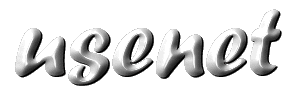- Découverte d'Usenet
- Usenet Pratique
- Usenet Technique
- Liens
- Qui sommes nous ?
Du bon usage de...

Son-of-RFC 1036
News Article Format and Transmission
Status of this Memo
This document is intended to become an Internet Draft. Internet Drafts are working documents of the Internet Engi- neering Task Force (IETF), its Areas, and its Working Groups. Note that other groups may also distribute working documents as Internet Drafts.
Internet Drafts are draft documents valid for a maximum of six months. Internet Drafts may be updated, replaced, or obsoleted by other documents at any time. It is not appro- priate to use Internet Drafts as reference material or to cite them other than as a "working draft" or "work in progress".
Please check the I-D abstract listing contained in each Internet Draft directory to learn the current status of this or any other Internet Draft. (Actually, this draft is at too early a stage to even be listed there yet.)
It is hoped that a later version of this Draft will obsolete RFC 1036 and will become an Internet standard.
References to the "successor to this Draft" refer not to later versions of this draft, but to a hypothetical future rewrite of this Draft (in the same way that this Draft is a rewrite of RFC 1036).
Distribution of this memo is unlimited.
Abstract
This Draft defines the format and procedures for interchange of network news articles. It is hoped that a later version of this Draft will obsolete RFC 1036, reflecting more recent experience and accommodating future directions.
Network news articles resemble mail messages but are broad- cast to potentially-large audiences, using a flooding algo- rithm that propagates one copy to each interested host (or group thereof), typically stores only one copy per host, and does not require any central administration or systematic registration of interested users. Network news originated as the medium of communication for Usenet, circa 1980.
Since then Usenet has grown explosively, and many Internet sites participate in it. In addition, the news technology is now in widespread use for other purposes, on the Internet and elsewhere.
This Draft primarily codifies and organizes existing prac- tice. A few small extensions have been added in an attempt to solve problems that are considered serious. Major exten- sions (e.g. cryptographic authentication) that need signifi- cant development effort are left to be undertaken as inde- pendent efforts.
Table of Contents
- Introduction
- Definitions, Notations, and Conventions
- Relation ton MAIL (RFC 822 etc.)
- Basic Format
- Mandatory Headers
- Optional Headers
- Control Messages
- Transmission Formats
- Propagation and Processing
- Gatewaying
- Security And Related Issues
- Archeological Notes
- A Quick Tour of MIME
- Summary of Changes Since RFC 1036
- Summary of Completely New Features
- Summary of Differences From RFC 822+1123